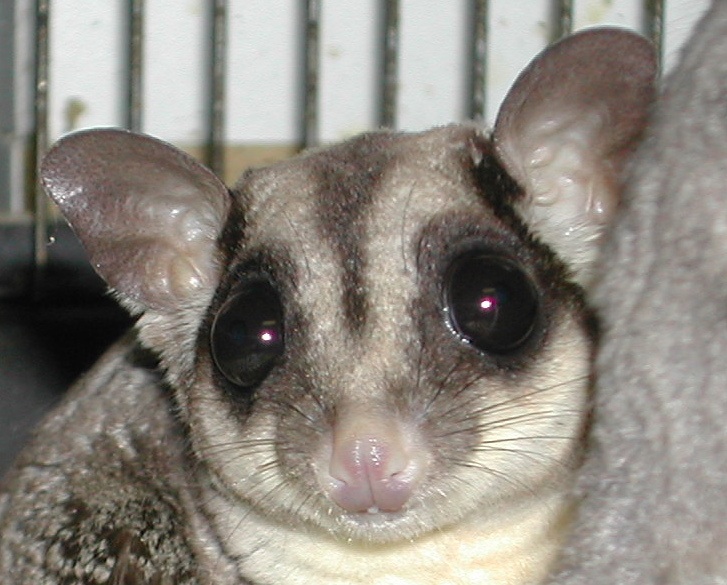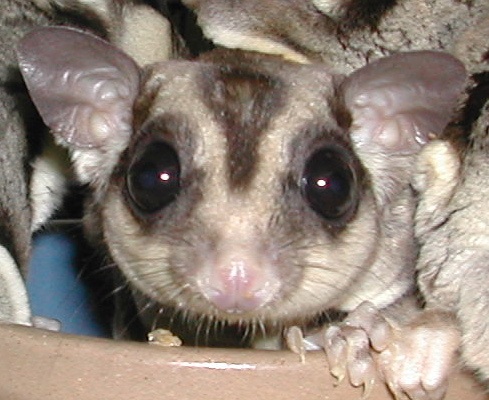|


What is a
sugar glider?
A sugar glider
is a small mammal that is similar in
appearance to a flying squirrel.
Actually, the sugar glider is a
marsupial and is a type of tree
opossum that is native to
Australia. Gliders are nocturnal
animals, with large, protruding eyes
specially adapted to enable their
excellent vision in low light
levels. A stretchy membrane of skin
spans from the wrist to the ankle
and can be extended when the animal
launches itself from tree tops,
branches and other perches. Gliders
have been known to glide for more
than 150 feet. The “sugar” part of
the name comes from the craving they
have for sweet, sugary items in
their diet that fuels their high
metabolism. Sugar gliders live in
small family groups tucked away in
tree hollows during the day,
emerging at dusk and early evening
to forage for food.
Is a Glider
the right pet for you?
This is a
question you should ask yourself
seriously for the benefit and long
term well being of the sugar glider
or gliders in your care. It is
important that you are realistic
about your commitment to caring for
a sugar glider, as a glider can die
from improper husbandry and
attention. You should expect your
glider to live for 10 to 12 years
or more with proper care, so it is also a
long term commitment. Glider care
is not difficult, in fact it’s
pretty easy when you follow some
basic guidelines, but it is the same
daily attention you would give a dog
or a cat. If you are looking for a
pet that you can tend to on the
weekends, give a water bottle and
pile of food to once a week, or
teach your kids a level of
responsibility with, then a hamster
or gerbil is a better choice for
you. If you are looking for a
rewarding, interactive pet that is a
little different from the usual
companion animals, a glider may be
for you. Please read on to make a
more informed decision.
What do I
need to keep a glider?
First, I
recommend getting a couple of
books on sugar gliders and
reading them through before you get
a glider. This will give you a
better idea of all that is involved
in caring for your glider properly.
Never rely on a single source for
all your information (yes, even
Harris in Wonderland is only one
source of information). Look at a
couple of web sites, talk to a
couple of people, read a couple
books.
Second, buy
a nice spacious cage with the
proper wire spacing (1/4” finch).
The cage should provide a good
amount of height and have several
platforms for the glider to
utilize. There are cages
manufactured specifically for
gliders and these are a great
choice. Some bird cages also work
well when they are properly adapted
to house a glider. Cages with the
dimensions 18” x 18” x 36” are
sufficient to house a glider, but if
you have the means to provide more
space, your glider will be very
appreciative.
Third, provide a good secure hiding place for your glider to sleep in during the day, either a nest box for a medium to large size bird or a fleece pouch that hangs on the side of the cage (Please see the warning about fleece pouches on our care sheet - care sheet coming soon, basically be aware that the gliders double claw that is meant for grooming snags easily in the fleece material and your glider can get caught and stress out, become weak or dehydrated, or even die under these circumstances).
Finally, proper foods need to be supplied daily and fresh water available at all times. These are the basic requirements that you will need to get started and keep your glider happy and healthy.
Caring For Your Glider
A newly acquired sugar glider will be nervous and frightened until it is acclimated to its surroundings. It is best to leave your glider alone after you arrive home and let him or her explore the new cage, hide box, food offerings, etc. Keep a close eye on your glider for the first few days to make certain that stress is kept to a minimum. Stressful situations tend to use up a tremendous amount of energy, and this can run your glider down in a hurry.
Once your glider has a good feel for his own space, you can and should begin to build your relationship with your glider. Expect about two to six weeks (depending on age, generally) of crabbing and lunging as your glider tries to protect itself. Young gliders are quickly won over with treats and rewards, and soon an association will be made between you and the deliverance of treats. Your glider will then be eager to greet you and see what you have brought.
Sugar gliders are nocturnal animals. They will begin stirring at dusk and will be most active at night. They often begin the night raiding the food dishes and barking communications to each other. For these reasons, it will be easiest to interact with your glider, at least initially, at dusk or early evening. Entice your glider to come out and greet you, perhaps climb onto your arm, and receive a treat. It won’t take long to gain the trust of your glider with daily interaction such as this. The more time you spend with your glider, the faster it will bond with you and the tamer it will get.
Feeding Your Glider
Proper nutrition is of course extremely important and is vital to the long term health and well being of you glider. I have found gliders to be very individualistic in their food preferences, so try a lot of different items to see what your glider enjoys most. Keep the diet as varied as possible, too.
Our gliders are always provided with a bowl of pelleted diet formulated specifically for sugar gliders. There are several available on the market now, and we carry a few different kinds to accommodate individual glider owners, but we use, sell, and recommend Exotic Nutrition’s Sugar Glider Total Diet. Often the pellets are the least favorite item on the daily menu for the sugar gliders, but it always available to our gliders and they will eat some before the night is through.
In addition to the pellets, one to three supplemental items are offered to our gliders just about each night. The following is a list of the items that are offered on a rotational basis:
Cantaloupe/Melon
Cherries
Strawberries
Orange slices
Hard-boiled eggs/Fresh raw quail eggs
Dried papaya (no preservatives)
Dried mango (no preservatives)
Yogurt/Yogurt Drops
Mixed vegetables (frozen or thawed)
Superworms
Mealworms
Waxworms
Crickets
Pinkie mice (I always use frozen ones)
Baby food (any of the fruity varieties)
Honey (sometimes drizzled over top of something else)
Whole grain cereals (such as cheerios)
Peanuts (don’t go over board with the nuts)
What's wrong with my Glider!?!
Sometimes things can go wrong concerning the health of your glider. When it is apparent that something is wrong it is imperative that you take steps to correct a problem immediately, as a glider will not live long under this type of stress. In other instances, a glider's behavior may change noticably under normal conditions and no action is neccessary. I will attempt to address a few of the common behavioral changes that I have noticed.
-My glider is weak, listless, and spends a lot of time "hugging" the bottom of the cage.
It is likely that your sugar glider has run low on energy and needs a quick boost to get back on his feet again. If your glider was acting fairly normal last time you saw him, but now seems weak, possibly shaking, irritable, and is slouching around the bottom of the cage, his high metabolism may have run him down. Give your glider some fruit juice, honey, or better yet, some Glideraid. Let him rest comfortably and in the future offer more of these sweet dietary suppliments.
-My glider seems overweight, is that possible?
Of course it's possible. Back off on the fatty foods, or avoid them altogether. Save the peanuts and waxworms for very special treats and re-examine your feeding regime. If your planning to breed your gliders, it appears that overweight gliders don't reproduce well.
-My gliders are all of a sudden very secretive, they don't even seem to come out to eat or drink!
If you have a male and a female glider, the answer here is that they likely are tending to babies. I have found that our gliders spend most of their time in the nest box for the first few weeks after new babies are born. Despite the fact that the females would seem to need more food and more water during this time, they apparently become more concerned with the health and care of the babies, living off of their fat reserves. Of course, you must continue to provide fresh food and water daily, wether they are eating it or not.
|